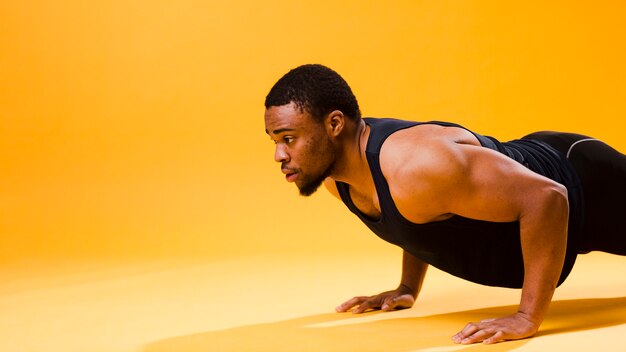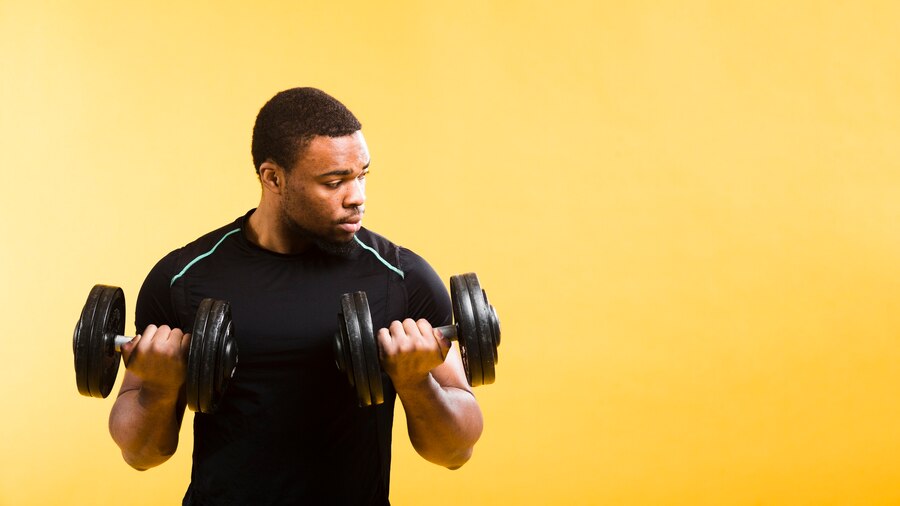Forget cables, it’s time to unleash your inner bird and take flight with exciting chest-building alternatives! Here’s a curated list to cater to every preference and equipment accessibility:
Free Weights:
- Dumbbell Flyes: Mimic natural movement for ultimate muscle engagement, offer independent arm control, and provide a vast range of difficulty adjustments.
- Plate Presses: Similar feel to flyes with a fixed weight path, ensure consistent tension, and are beginner-friendly.
- Dumbbell Pullovers: Target chest, lats, and shoulders for comprehensive work, improve flexibility, and can be done with body weight or weights.
Bodyweight:
- Push-ups: The ultimate portable exercise, offers multiple variations (incline/decline, diamond) to target different chest areas.
- Dips: Compound exercise for chest, triceps, and shoulders, adjustable difficulty with chair dips or weighted vests.
Machines:
- Pec Deck Machine: Guided movement ensures good form and isolation, beginner-friendly with adjustable weights.
- TRX/Suspension Trainer Exercises: Unstable surface challenges core and improves balance, adjustable angles mimic cable fly movements.
Bonus:
- Isometric Chest Holds: Build static strength and control, ideal for pre-activation.
Remember:
- Choose options that align with your goals, equipment access, and fitness level.
- Combine exercises for a well-rounded workout.
- Prioritize proper form over heavy weights.
- Have fun and experiment to find your favorites!
Ready to delve deeper? Explore the detailed sections for each category, including pros, cons, and helpful tips!
So, spread your wings, embrace the freedom, and watch your chest soar to new heights! There is an article I wrote about >>>>> Alternatives to Cable Kickbacks: Building Strong Glutes Without the Machine that you should read to learn more.
Cable flyes have long been a gym staple for chest sculpting, but they’re not for everyone. Whether you lack access to a cable machine, crave more exercise variety, or want to explore different training options, there’s a world of alternatives waiting to be unleashed.

In my 25 years as a fitness expert, I’ve witnessed countless exercisers achieve impressive chest gains using various methods. Let’s delve into the top contenders, exploring their pros, cons, and unique benefits:
I. Free Your Inner Bird with Free Weights:
A. Dumbbell Flyes: The Natural Choice:
- Pros: Mimic natural chest movement for optimal muscle engagement. Offer independent arms control, ideal for addressing imbalances. Provide a vast range of difficulty adjustments, catering to beginners and seasoned lifters alike.
- Cons: Require more core stability compared to cables, demanding focused engagement. Risk of bottoming out weights, potentially reducing tension at the peak of the contraction.
- Variations: Incline/decline flyes target specific chest regions (upper/lower). Single-arm flyes build unilateral strength and stability.
B. Plate Presses: Fixed Path, Focused Gains:
- Pros: Offer a similar feel to flyes with a fixed weight path, simplifying form. Ensure consistent tension throughout the movement, making them beginner-friendly. Suitable for those with stability concerns.
- Cons: Less versatile than dumbbells, limiting muscle activation angles. Not as readily available in all gyms.
C. Dumbbell Pullovers: Stretch, Strengthen, Conquer:
- Pros: Target not just the chest, but also lats and shoulders for a comprehensive workout. Stretch the chest muscles, improving flexibility and mobility. Can be done with body weight or weights, adapting to various fitness levels.
- Cons: Require good shoulder mobility to avoid impingement. Maintaining proper form can be challenging, especially for beginners.
II. Bodyweight Bliss: No Gym, No Problem:
A. Push-ups: The OG Chest Builder:
- Pros: The ultimate portable exercise, requiring no equipment and doable anywhere. Offer multiple variations to target different chest areas (incline/decline, diamond push-ups).
- Cons: Limited weight resistance, making them less suitable for advanced exercisers. Can be harder on wrists and shoulders than cable flyes.
B. Dips: The Compound King:
- Pros: A fantastic compound exercise, working chest, triceps, and shoulders simultaneously. Adjustable difficulty with chair dips or weighted vests for progressive overload.
- Cons: Demand significant upper body strength, not ideal for beginners. Improper form can increase risk of shoulder injury.
III. Machine Marvels: Convenience with a Caveat:
A. Pec Deck Machine: Guided Flight:
- Pros: Guided movement ensures good form and isolation, making it beginner-friendly. Adjustable weight stacks allow for varying intensity levels.
- Cons: Limits natural movement patterns compared to free weights, potentially reducing overall muscle activation. Engages core and stabilizers to a lesser extent.
B. TRX/Suspension Trainer Flight Plan:
- Pros: The unstable surface challenges your core and improves balance. Adjustable angles replicate cable fly movements, offering versatility.
- Cons: Requires familiarity with TRX setup and exercises, potentially presenting a learning curve. Not available in all gyms, limiting accessibility.

Remember, the “best” alternative depends on your individual goals, fitness level, and equipment availability. Experiment, listen to your body, and find the options that make your chest soar!
Bonus Tip: Consider incorporating these alternatives into a chest workout routine, mixing and matching them for a well-rounded challenge.
Remember, consistency and proper form are key to achieving your fitness goals, regardless of the tools you choose. So, ditch the limitations and embrace the freedom to fly with alternative exercises!
IV. Pro-Cons Roundup: A Bird’s-Eye View.
Now that we’ve explored the exciting alternatives to cable flyes, let’s take a step back and compare the pros and cons of each category for a clearer picture:
Free Weights:
- Pros:
- High versatility and muscle activation angles.
- Independent arm control for addressing imbalances.
- Wide range of difficulty adjustments.
- Cons:
- Requires more core stability and control.
- Risk of bottoming out weights and reducing tension.
- May not be beginner-friendly for all variations.
Bodyweight:
- Pros:
- Convenient and accessible, requiring no equipment.
- Multiple variations target different chest regions.
- Improve overall strength and bodyweight control.
- Cons:
- Limited resistance for advanced exercisers.
- Can be harder on joints compared to other options.
- Progression can be slower due to limited resistance options.
Machines:
- Pros:
- Easy to use and maintain proper form.
- Controlled movement minimizes the risk of injury.
- Adjustable weights cater to various fitness levels.
- Cons:
- Limit natural movement patterns, potentially impacting muscle activation.
- Less engaging for core and stabilizers.
- May not be available in all settings.
Remember:
- No single category is inherently “better” than the others.
- Choose the options that align with your goals, equipment access, and fitness level.
- Combine exercises from different categories for a well-rounded chest workout.
- Listen to your body and prioritize proper form over heavy weights.

As a fitness enthusiast for over two decades, I’ve seen individuals achieve remarkable results with all these alternatives. The key lies in consistency, proper technique, and finding the exercises that spark your training joy. So, take flight with the options that resonate with you, and watch your chest soar to new heights!
Ready to dive deeper? Let’s explore some frequently asked questions related to cable fly alternatives:
- V. Highly Related Questions:
- Best cable fly alternatives for building upper chest definition?
- Can resistance bands effectively replace cable flyes for home workouts?
- Are there safer cable fly variations for preventing shoulder injuries?
- How to transition from cable flyes to more challenging chest exercises?
- Isometric chest holds vs. cable flyes: Which is better for overall chest development?
Stay tuned for the next section, where we’ll delve into these questions and provide insightful answers to guide your fitness journey!
Now that we’ve equipped you with a diverse arsenal of cable fly alternatives, let’s address some burning questions that may be clouding your training path:
1. Best Cable Fly Alternatives for Building Upper Chest Definition?
For sculpting that coveted upper chest definition, prioritize exercises that emphasize shoulder flexion and adduction. Top contenders include:
- Incline Dumbbell Flyes: Angle your bench at 30-45 degrees to target the upper pec fibers. Focus on squeezing your chest at the peak of the contraction.
- Low-to-High Cable Crossovers: Start with your arms below your torso and bring them to a high crossover point, mimicking the upward trajectory of the upper chest fibers.
- Decline Push-ups: Elevate your feet on a bench or box to shift the focus towards the upper pecs. Perform with strict form and controlled movements.
Remember, consistency and progressive overload are crucial for sculpting definitions. Gradually increase your reps, sets, or weight over time to keep challenging your muscles.
2. Can Resistance Bands Replace Cable Flyes for Home Workouts?
Yes, resistance bands can be effective substitutes for cable flyes in a home setting. Choose bands with appropriate resistance and anchor them around a secure doorframe or post. Mimic the cable fly movement by pulling the bands apart with controlled motions.
However, the variable resistance of bands may not provide the same progressive overload potential as cable machines. You can compensate by incorporating drop sets or supersets with different band tensions.
3. Safer Cable Fly Variations for Avoiding Shoulder Injuries?
If shoulder concerns are a factor, consider these safer cable fly adaptations:
- Neutral Grip Cable Crossovers: Use a neutral grip instead of the traditional palms-facing approach to reduce stress on the anterior deltoids.
- High Pulley Flyes: Set the pulley at a high point to minimize shoulder flexion and focus on chest isolation.
- Single-Arm Cable Crossover with Internal Rotation: Start with your arm slightly behind your torso and pull the cable inwards, promoting internal rotation and reducing excessive external rotation stress.

Always prioritize proper form over heavy weights. Stop any exercise that causes pain or discomfort, and consult a qualified trainer if needed.
4. Transitioning from Cable Flyes to More Challenging Chest Exercises:
Ready to graduate from cable flyes? Dive into these advanced chest-busters:
- Weighted Dips: Add a weight vest or hold dumbbells between your legs for an intense compound exercise targeting chest, triceps, and shoulders.
- Decline Dumbbell Bench Press: Elevate your feet on a bench to emphasize the lower pecs and challenge your core stability.
- Svend Press: This unique exercise with a medicine ball incorporates rotational movements to strengthen the entire core and pecs.
Remember, proper form is paramount with advanced exercises. Seek guidance from a trainer if needed to ensure safe and effective technique.
5. Isometric Chest Holds vs. Cable Flyes: Chest Development Showdown.
Both isometric chests holds and cable flyes have their merits:
- Isometric Chest Holds: Build static strength and improve muscle control by holding a contracted chest position against resistance, like pushing against a wall. Effective for pre-activating muscles before workouts.
- Cable Flyes: Provide dynamic tension throughout the range of motion, promoting muscle growth and functional strength. Ideal for building contractile strength and muscle mass.
The best approach? Integrate both! Use isometric holds as a warm-up or activation tool, followed by dynamic exercises like cable flyes for comprehensive chest development.
Remember, your journey to a sculpted chest is an individualized adventure. Experiment with the diverse alternatives, choose what resonates with you, and prioritize proper form and consistency. And above all, have fun exploring the exciting world of chest-defining exercises!
So, with this s-eye view of cable fly alternatives and insightful answers to your burning questions, take flight and soar towards your fitness goals!
I am commitment to crafting compelling narratives and delivering insightful content continues to inspire and inform readers across various platforms. Explore her articles on AlternativesZone.com and FactAfterFact.com to experience a rich tapestry of knowledge and discovery. Here I Analyze and Test the products and services together with my team before we recommend them to our users. Nice Reading Here!








No responses yet